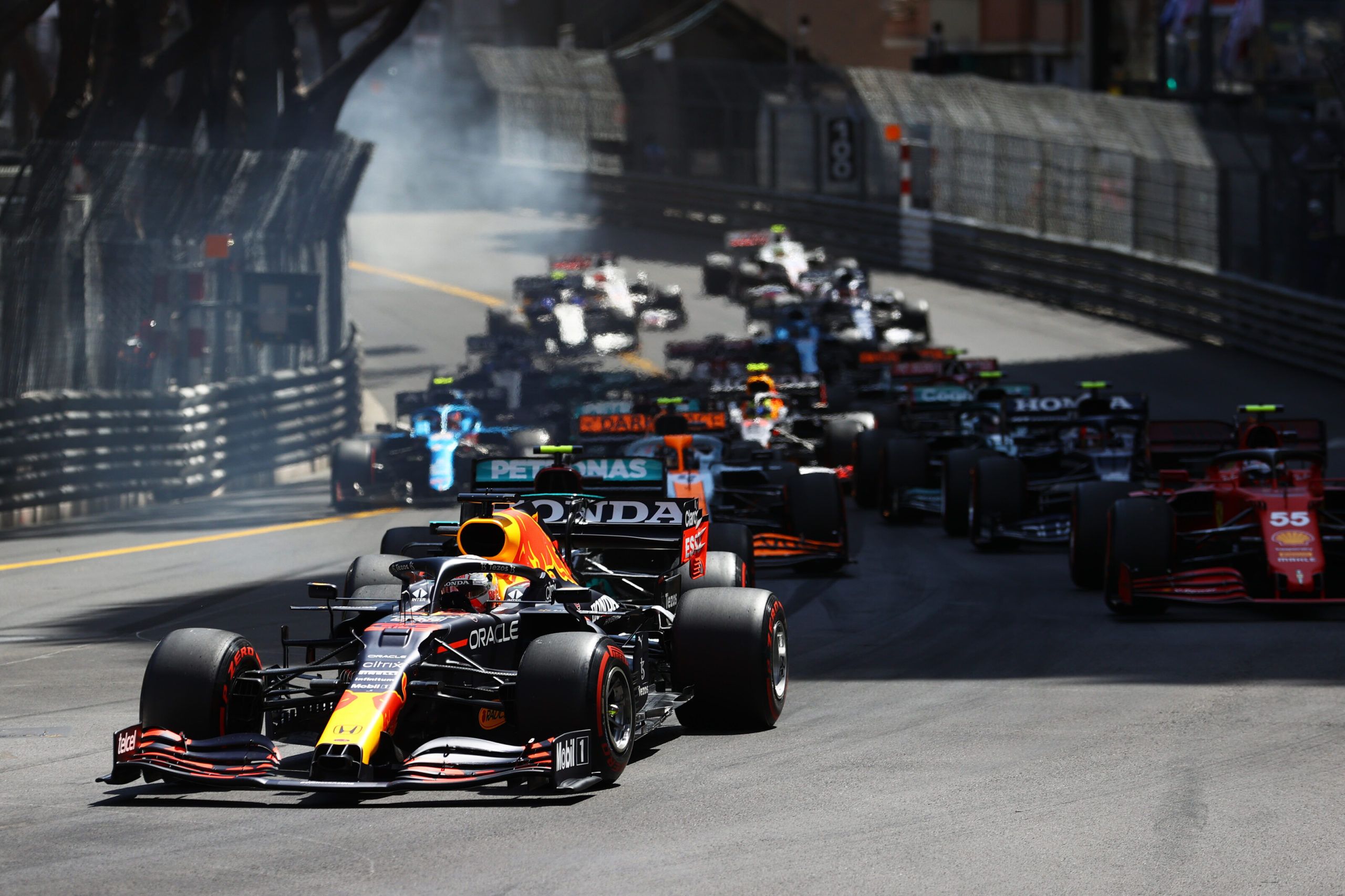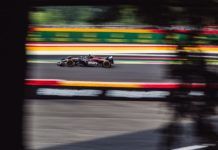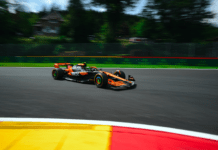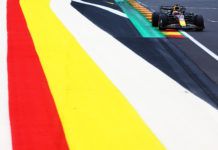Flexi wings, to be monitored by the FIA as of the F1 French GP, have become a controversial topic of late, after Mercedes accused Red Bull of exploiting them.
Flexible aerodynamics have long been a concern of the FIA, but the F1 sport’s governing body has in the past found a hard time policing flexi-wings given the inherent challenges associated with determining whether or not a car’s aerodynamics were made more flexible on purpose.
After Mercedes’ talks of a “bendy” rear wing on the RB16B, the FIA promised to monitor wing flexibility starting at this year’s F1 French GP. But between then and now remains the Azerbaijan GP, where Hamilton claims Red Bull can continue to gain “six tenths [of a second].”
“It’s going to be worth at least six tenths there probably. So I think we naturally just need to continue to apply pressure to the FIA to just do a better job at controlling these,” Hamilton told Sky Sports F1. Red Bull boss Horner denied that the advantage from a flexible rear wing would be as great as Hamilton claims.
“It’s difficult to quantify, but it’s not as much as people think. I’ve heard comments of six tenths being bandied around, which is ludicrous. I mean, if you’re talking about a tenth, I’d be surprised. All these things have to work in conjunction with every other component on the car. So it’s going to vary from circuit to circuit,” Horner replied.
Mercedes F1 boss Toto Wolff backs Hamilton, and even says that the FIA risks a protest by only providing a “half-baked” response to his and Mercedes’ concerns. This controversy prompted further discussion of the topic in the Monaco GP press conference, where Wolff and Horner were among the six team bosses to discuss the issue.
In the F1 press conference and elsewhere in the media, Ferrari openly admitted to exploiting the flexi-wing concept, while others fervently denied using such aerodynamics and expressed displeasure with the FIA for their handling of the situation. The following is what was said:
On the actions being taken by the FIA –
Toto Wolff: “We have seen in the past that complicated redesigns for teams had a delay. It’s clear that, if you have a back-to-back race, or maybe even two weeks, it’s too short for everybody to adjust – but we’re having four weeks to Baku and it is incomprehensible that, within four weeks you can’t stiffen-up a rear wing for the track that is probably the most affected by flexible rear wings. That leaves us in no-man’s land, because the FIA F1 Technical Directive says the movement of some rear wings has been judged as excessive – so teams who would run these kinds of wings are prone to being protested and probably this is going to do to the ICA, and nobody needs this messy situation.”
Mattia Binotto (Ferrari): “At first, obviously what’s happening on the rear wing, I think it’s normal administration as whatever is happening in F1, always trying to push the boundaries, and somehow the FIA tried to clarify the intentions and the principles of the regulations. Now, on the time, I’m pretty sure that the FIA checked deep what was right, what was wrong, I’m pretty sure that by deciding a certain date, they somehow analysed pretty well, the case and I trust them fully. As Ferrari, we are happy there is now a clarification and eventually we need to adapt, or someone needs to adapt – whoever – to that new Technical Directive but on the time I think we should respect the FIA decision because I’m pretty sure they did it be being fully aware.”
Laurent Rossi (Alpine): “On our end, we designed a F1 car that conformed to the regulations. If the tests prove that we need to comply to a new set of rules, we will do that. That’s all I can say.”
Frederic Vasseur (Alfa Romeo): “It will affect everybody. At the end of the day, we have the F1 regulation with the maximum deformation under load and I think we are not more clever than the others. Everybody was sticking to the limit, and the FIA decided to change the limits. It’s a bit surprising, but they changed the [test] load and the deformation [permitted] – and in the course of the season. It’s not the introduction of a new test or a new way to do the test, it’s just that they change the [load] value.”
On whether or not changes will have to be made to their respective cars –
MB: “Yes, we are exploiting. I think as all the F1 teams are exploiting somehow what’s possible and what we believe is right. The Technical Directive is clarifying further. We will need to slightly adapt but I don’t think it’s impacting Ferrari much – and certainly on the lap time from what we’ve seen, very, very little but there are some redesigns just needed which need to be carried over somehow to comply fully to the Technical Directive. Again, I think that, as Ferrari, it’s not impacting us much but still, a redesign is required.”
TW: “I think before, let me clarify, each of us three here is doing the job and needs to adapt to the regulations. We have been left in a limbo since a long time. We have flagged the flexible rear wing situation last summer, without having received any feedback and I understand some of the F1 teams’ frustration when, making the concept of this year’s car, that this was an area that should have been tackled much earlier. To come back to Andrew’s question, yes, we will need to modify our wing. We need to soften it. Our wing is extremely rigid, complying to the famous article 3.8 that it must remain immobile. The new test that has been introduced is a half-baked solution which is giving us opportunity and the whole thing can soften and can bend more in the future.”
LR: “I’m not going to add much more to what Mattia said. We’re going to make the modifications. I’m an engineer so I’m going to refrain from having a comment on the impact before my engineers give me a result. It would be an insult to their knowhow, so I will just say ‘we will adapt’. We’ll see how much it costs us, if anything.”
Christian Horner: “Well, the car is designed to comply with the regulations and of course there are tests that the FIA have for most of it and our car complies with all of those tests. Now, occasionally the FIA will change those tests, which they have the right to do. They’ve done that and that of course means that effectively it’s a change in regulations in many respects so of course there have to be changes made to the product and that’s expensive and of course time-consuming. But a lot of focus is on the rear of the car at the moment and I’m sure that in due time that’s also going to move round to other areas of the car that other teams will come under scrutiny, so of course it’s not just Ferrari and Red Bull that are affected. I think Sauber are quite badly affected by this as well, but that’s F1, that’s what happens when Technical Directives get issued that change things like the tests that rear wings are subjected to.”
Jost Capito (Williams): “I think that for every F1 team it’s the same, the same as Christian, it’s valid for everybody. For us, it’s no impact but we might not have looked carefully enough at the regulation when we designed this car.”
Andreas Siedl (McLaren): “I think if you see the pictures and footage from Barcelona, it is clear what’s happening there, therefore we also welcome what the Technical Directive of the FIA says, to put an additional or different test in place, which helps them to check the cars here in a pragmatic way at the F1 race tracks. But at the same time, we strongly disagree with the timing of the introduction. For us, there’s no reason why it should be late for the two races and if the guys that have designed the cars in order to have these flexi-wings two more races, to have the benefit from it because from our point of view, what these guys are using is clearly against the regulations because the test that is in place is not the only criteria you have to meet in terms of being compliant with the regulations. That’s why we are having a dialogue with the FIA at the moment, because I think it’s a good opportunity for the FIA to show a strong hand here and not accept this any more, from today onwards and yeah, we take it from there.”
Guenther Steiner (Haas): “For us, it is not an issue because we don’t have a flexi wing. It is like the teams which have the flexi wing will have an opinion about it, so I am ok with whatever the majority of the teams decide to do. But it is [already] decided by the FIA by them issuing a technical directive that this is not allowed. For us, it is not an issue, so we don’t really are in the game for it.”
FV: “Honestly, it will be marginal because we did the back to back a couple of times and the difference was not huge. And it’s not about this. My concern is why next week won’t we change the weight of the car, also? Because one team is not able to reach their limits. I don’t know. I’m a bit upset with the approach to change the rule. To change the value of the test is not fair at all because the business of the engineers in F1 and the designs is to design parts at the limit of the regulation. If you change the regulation in the course of the season, you will have to design new parts and the teams who are saying that they won’t be affected, it’s a joke.”
Otmar Szafnauer (Aston Martin): “It’s very track-specific. At some F1 tracks, it doesn’t help much at all, and at others, to have a flexi rear-wing does help. I think a little bit, it will come our way [low-rake] a little bit, maybe by on average a couple of tenths of a second per lap or something. But there are some tracks where you get zero benefit, and others it could be up to half a second. To design something that flexes just the right amount and passes the test but still flexes, takes a big effort.
“But to design something that is stiff doesn’t take effort at all. And it can be done very, very quickly. It’s something our technical team would do but I can assure you, everything flexes. You’ve got to understand that. There is nothing that has infinite stiffness so if you put a big enough force on it, everything is going to flex. But we don’t flex nearly as much as the others. We have a stiff rear wing and I’m happy the FIA are doing something about it.”
On whether or not a protest is being considered before Baku –
TW: “We had in the past a situation, I remember DAS last year, and every year we had these situations but this one, as I said before, delaying the introduction for whatever reason leaves us in a legal vacuum. It leaves the door open for protests. It’s not only us but it’s probably two other teams that are most affected. Maybe more. Obviously a protest could end up in the ICA. So – and that is a messy situation. It can take weeks before we have a result. And we should not have ended in this situation if we’re having four weeks to the race that is most relevant in the calendar.”
On Red Bull’s ability to strengthen its wings before Baku –
CH: “When you’re effectively changing a rule, there has to be a lead time. You can’t just magic up components. I think if they changed the test on the front wings, for example, this weekend and we’ve seen far more performance from front wing flexibility, shall we say, then that would affect every single team, some much greater than others and I think that there has to be a lead time. You can’t expect parts just to magicked up overnight with the costs that are incurred with that. The car complies with the regulations that have been there for the last 18 months or so with these load tests and then the test or the regulation has been changed or the test has been changed and there has to be a notice period for that.”
On the budget cap implications of this rule change –
AS: “For us it doesn’t have any influence because we don’t have to change anything on the car. Our car was compliant with the regulations for the first races, it’s compliant now and I just want to make it clear as well that the Technical Directive is not a new regulation, it’s just an additional or different test, but the basic regulation, especially article 3.8, which is the key one, doesn’t change.”
CH: “Well, I think for a team like us that is obviously running up against the F1 budget cap, then of course strategically you have to make choices. The impact of something like this is probably about half a million dollars so you’ve got to… that will prevent something else from happening, so that’s the juggling act that we’re now having to make with the budget cap and financial regs.”
JC: “Yes, in this special case, there’s no impact to us but our F1 budget is quite a bit below the cost cap but that means we have to work very efficiently because we don’t have the resources that the bigger teams have. On the other side, you have to have something in the back, like the crashes that we had in Imola, they are cost effective (sic) and even if you are not with the cost cap it affects your budget and I think you have to have something in the budget for unforeseen accidents, things like this, you have to, and you have to cope with it and I think that what makes… that was the idea and also the sense of the cost cap to cope with this.”
FV: “This is the first time that we see something like this, because if you are at the limit, if you did a good job, you have to produce new wings. But in terms of cost-saving, it’s a huge, huge, huge effort. We have time to do it, but it will cost us a fortune. We are all fighting to try to save money, to speak [about] reducing one person at the track. And then we have these kinds of things that is just a joke, a joke for me.”
Here’s Toto Wolff and Christian Horner on front and rear wing
Here’s Mercedes and Red Bull on flexi wings



















